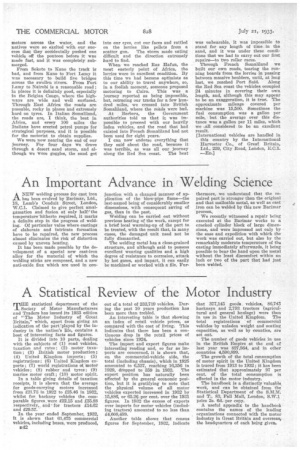A Statistical Review of the Motor Industry
Page 56

If you've noticed an error in this article please click here to report it so we can fix it.
rplIE statistical department of the J_ Society of Motor Manufacturers and Traders has issued its 1933 edition of "The Motor Industry of Great Britain," which, apart from giving an indication of the part 'played by the industry in the nation's life, contains a host of interesting facts and figures.
It is divided into 10 parts, dealing with the subjects of (1) road vehicles, taxation and rates ; (2) motor taxation; (3) British motor production ; (4) United Kingdom imports; (5) registrations; (6) United Kingdom exports ; (7) world registrations oi 'motor vehicles; (8) rubber aud tyree; (9) marine motor craft; (10) motor spirit.
In a table giving details of taxation receipts, it is shown that the average for goods-carrying motors increased from £21.73 in 1922 to £25.46 in 1932, whilst for hackney vehicles the, comparable figures. were 422.15 and £35.88 respectively,, and for tractors 114.62 and £29.57.
In the year ended September, 1932, It is shown that 61,475 commercial vehiclee, including buses, were produced, out of a total of 232,719 vehicles. During the past 10 years production has been more than trebled.
An interesting table is that showing an index of retail vehicle prices, as compared with the cost of living. This indicates that there has been a continuous drop in the retail prices of vehicles since 1924.
The import and export figures make interesting reading and, so far as imports are concerned, it is shown that, on the commercial-vehicle side, the total (including chassis), which in 1925 amounted to 6,537, reaching 16,356 in 1929, dropped to 359 in 1932. The export position has naturally been affected by the general economic position, but it is gratifying to note that the physical volume of all motor vehicles exported increased in 1932 by 15,886, or 65.26 per cent. aver the 1931 figures. In 1932 the excess of exports over imports for motor vehicles (including tractors) amounted to no less than 14,608,459.
Another table shows that census figures for September, 1932, indicate that 377,145 goods vehicles, 86,743 hackneys and 2,793 tractors (agricultural and general haulage) were then in use in the United Kingdom. The total registrations of commercial vehicles by unladen weight and seating capacities, as well as by counties, are set out.
The number of goods vehicles in use in the British Empire at the end of last year was 827,564, and in other countries 4,590,899.
The growth of the total consumption of motor spirit in the United Kingdom is traced from 1913 to 1932; it has been estimated that approximately 97 per cent. of the total consumption is effected in the motor industry.
The handbook is a distinctly valuable work, and can he obtained from the Statistical Department of the S.M.M. tind T., 83, Pall Mall, London, S.W.1 price 2s. 6d. per copy.
A useful appendix to the handbook contains the names of the leading organizations connected with the motor industry in Great Britain and overseas; the headquarters of each being given.




























































































